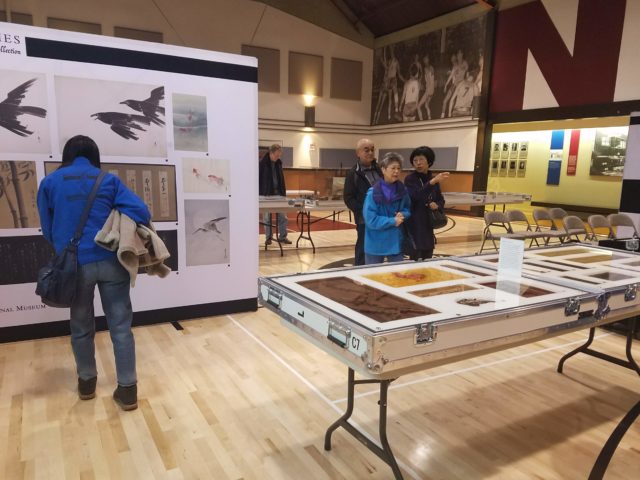By Stephanie Ikeda, the North American Post
The traveling exhibit Contested Histories was on view at the Nisei Veterans Foundation Hall November 24-25. The exhibit, which has already visited several West Coast locations, was organized by the Japanese American National Museum (JANM), and showcases World War II incarceration camp art pieces from the Allen Hendershott Eaton collection with the hopes of finding stories and individuals in connection with the artifacts. Eaton was a folk art enthusiast and author who visited the camps as well as hiring a photographer to research a book he would later publish called Beauty Behind Barbed Wire.
Eaton did not keep detailed records of what he collected during the war, but it was clear that the Japanese American families who donated items for his research did not want to sell them to him. Despite this, after his death the collection changed hands several times and in 2015 was put up for auction by a well-known auction house, Rago Auctions. The New York Times published an article about the sale which alerted the nationwide Japanese American community and led to the creation of the “Japanese American History: Not for Sale!” Facebook page. Although the community tried many strategies including online petitions, Rago Auctions did not cancel the sale until the Heart Mountain Foundation filed an injunction against them. Following this, the entire collection was transferred to custody of JANM.
Fast forward to 2018, JANM has organized and launched Contested Histories. The exhibit has several cases of objects from the collection but also full binders with images and data for the complete collection of artifacts and photographs that Eaton collected from various camps. JANM representative Clement Hanami also gave a presentation about the history of the collection and shared several videos recording stories they had already discovered in the process of traveling with the exhibit. The showing in Seattle attracted a multi generational audience with many families bringing older relatives to go through the materials.
One story related to the Seattle community involves a wooden chair that is one of the central pieces of the collection. The chair, valued by Rago Auctions as a starting price of 350 dollars, is “priceless” according to Mr. Hanami’s reflection on the community history. Nancy Ukai, a researcher and organizer of the “Not For Sale” movement, discovered an Eaton letter referring to the chair as the Homma chair. Historian Mitch Homma had no knowledge of the chair but Seattle relatives of the Homma family were able to identify the owners as Shige & Yorozu or Mary and Peter Homma,
known by other nicknames to the living descendants.
With the long – term goals of preserving, sharing, and researching the collection, JANM has also posted the exhibit catalog on their website at JANM website if you missed the showing in Seattle. According to Mr. Hanami, the journey of the exhibit has generated more and more interest and information the more places it tours and encourages everyone to learn about and spread the word about the collection.
The exhibit will continue to be shown after its West Coast tour including stops in Chicago and the Rohwer Pilgrimage. The full traveling schedule is available on JANM’s Contested Histories website.





